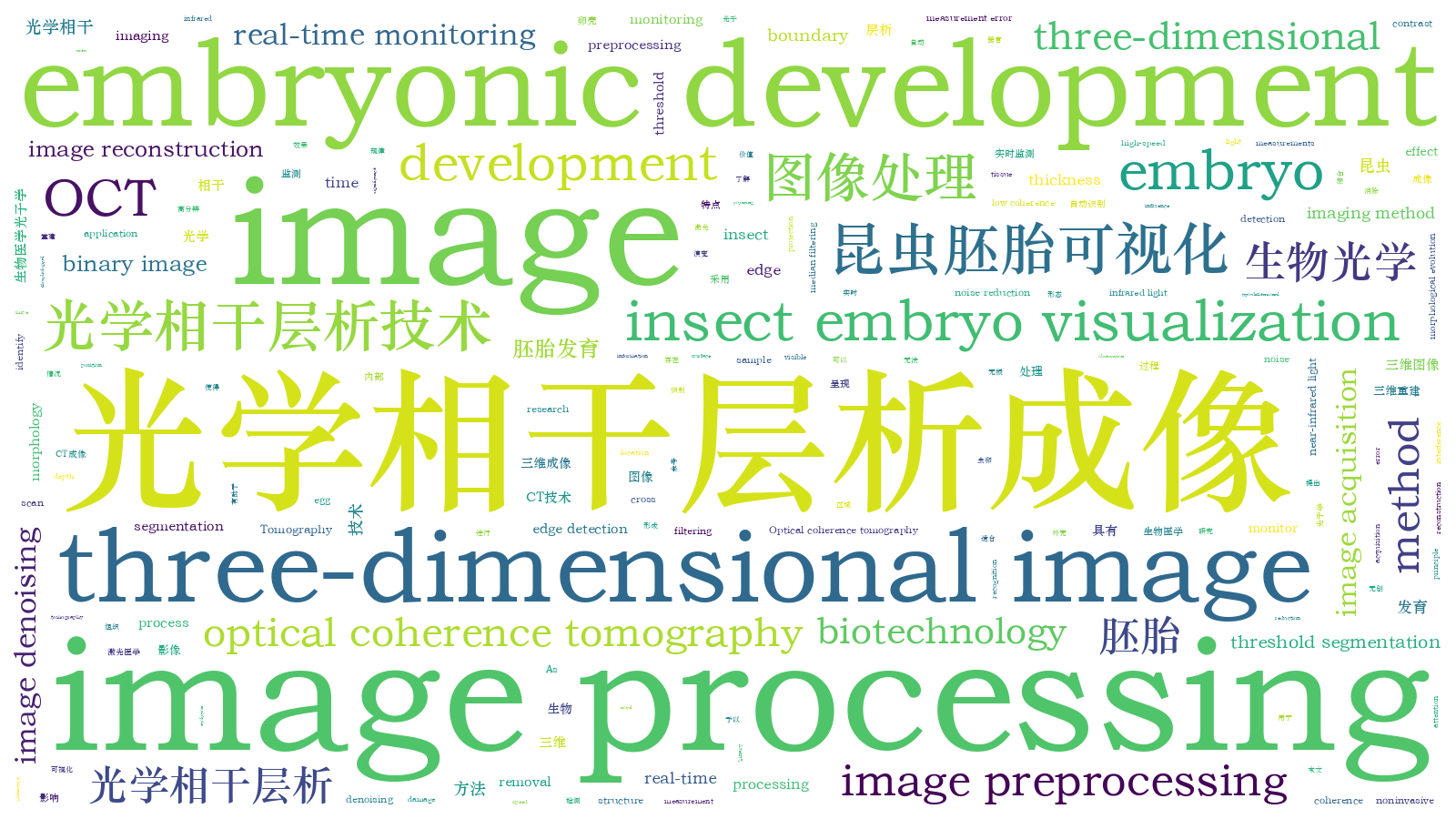基于光学相干层析技术的昆虫胚胎影像处理方法  下载: 808次
下载: 808次
Objective Embryonic development has attracted increasing attention in biological research. Monitoring the internal organs and tissues of an embryo is relevant to the study of embryonic development. Generally, two methods are employed to monitor tissues in the embryo: tissue section technology and stereomicroscope observation. Both methods need to kill the embryo and cannot monitor a single living embryo continuously. Therefore, noninvasive real-time monitoring of embryonic development is expected to understand the morphological evolution process. Optical coherence tomography (OCT) is a relatively novel imaging method in the 21st century and is based on the principle of low coherence interference. It uses near-infrared light to scan the sample noninvasively, and then a three-dimensional image reconstruction is performed. OCT can provide internal structure information with a depth of 1--12 mm below the sample surface. Several research groups have reported studies on the embryonic development of different animals, such as Xenopus, mice, and birds, using OCT. However, there are few reports on the application of OCT to insect embryonic development. The main reason is that insect embryos are usually wrapped with eggshells that protect the embryo from external damage. This morphology of the insect embryo significantly affects the real-time monitoring of its development. Therefore, a method that can automatically identify the edge and thickness of the eggshell and intelligently erase it is required.
Methods An image processing method is proposed in this paper to eliminate the effect of eggshells on OCT imaging. This method can automatically identify and erase the area of the eggshells so that the clear three-dimensional image of the embryo inside the eggshell is presented. As shown in Fig.1, first, the three-dimensional image is filtered to reduce noise; second, local threshold segmentation and boundary recognition are performed; and then the position and thickness of eggshells can be extracted and erased in the original image. Afterward, the three-dimensional image of the embryo phenotype can be presented. Noise is often introduced during the real-time OCT image acquisition process, which can severely influence the effect of eggshell edge detection. Therefore, the original three-dimensional image denoising is an indispensable operation in image preprocessing. After comparing various image-denoising methods (Fig.2), the median filtering is selected. Figure 5(b) shows that the contrast is higher between the eggshell edge and the internal structure after noise reduction. However, the inner boundary of the eggshell is still connected with the yolk and embryo, which can cause measurement error when extracting the thickness of the eggshell. Therefore, local threshold segmentation is employed to solve the problem, and detailed procedures are shown in Fig. 4. Figure 5(c) shows the binary image in which the grey value of the eggshell is 255, whereas, other regions are 0 after local threshold segmentation. Hence, the first junction between 255 and 0 is the outer boundary of the eggshell, and the second is the inner boundary. Thus, the location and thickness of the outer and inner boundary of the eggshell can be obtained by counting the number of pixel points with a grey value of 255 between the two junctions in each A-scan image. Notably, the eggshell edge is non-smooth after local threshold segmentation. Consequently, the second filtering is used to smoothen the edge, which ensures accurate measurements.
Results and Discussions Figure 6 shows the comparison of OCT imaging results before and after eggshell removal on the 11th day of locust egg development. As shown in Fig. 6 (a), the internal morphology of the embryo is covered by eggshell and is not visible. After using the eggshell removal method to process the image, the head, antennae, abdomen, and feet of the embryo are clearly seen in the three-dimensional projection of XY [Fig. 6(b)]. Figures 6 (c) and (d) are two-dimensional cross-sectional images of XY with depths of 0.67 and 0.88 mm, respectively. Although these cross-sectional images are not affected by the eggshell, they cannot reflect the overall changes of the embryonic development morphology and are significantly different from the three-dimensional image of Fig. 6(b). By contrast, Fig. 6(b) is a suitable three-dimensional image to study embryonic development. Therefore, this is the purpose and significance of the eggshell removal method proposed in this paper. Equipped with the eggshell removal method, Fig. 7 shows the embryonic development process observed on days 6 to 14 clearly.
Conclusions Because the insect embryo is wrapped by an eggshell, the three-dimensional OCT image cannot directly show the whole morphology of the embryo inside the egg. Therefore, in this study, we propose an image processing method to eliminate the effect of eggshell on OCT imaging. This method can automatically determine the boundary and thickness of eggshell and erase it. Compared with traditional invasive detection methods that are complicated in operation, time-consuming, and cannot continuously monitor a single living embryo, OCT has the advantages of noninvasive, real-time, and high-speed nature to obtain more accurate monitoring results of embryonic development. This image processing method is helpful to the application of OCT in the study of insect embryonic development.
买童童, 魏丽亚, 姚晓天, 苏亚, 王秀丽, 杨丽君. 基于光学相干层析技术的昆虫胚胎影像处理方法[J]. 中国激光, 2021, 48(9): 0907002. Tongtong Mai, Liya Wei, Steve Yao X., Ya Su, Xiuli Wang, Lijun Yang. Image Processing Method of an Insect Embryo Based on Optical Coherence Tomography[J]. Chinese Journal of Lasers, 2021, 48(9): 0907002.







